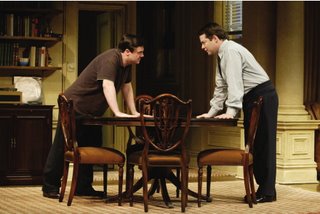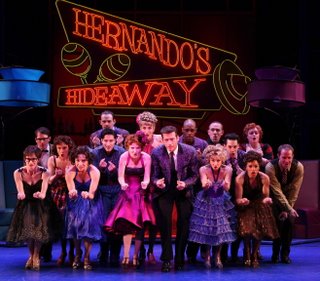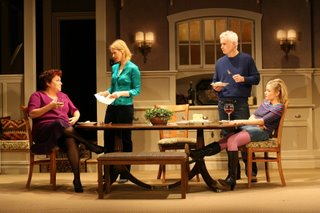Live Design magazine has obliged me with a soapbox to air my views on current theater offerings, in its weekly Seen and Heard feature (which, I should add, I devised five years ago when LD was two separate publications, which recently merged). The web being what it is, they tend to vanish pretty quickly off the site, but I've decided to resurrect and reedit a few entries for alternate consumption here as a kind of seasonal snapshot. I'll do the same with off-Broadway shows in an upcoming post. "Another op'nin, another show," as they sing in KISS ME KATE.
JERSEY BOYS
JERSEY BOYS, at the August Wilson, revives the jukebox musical, a form many hoped the abject failures of GOOD VIBRATIONS and LENNON, and the more appealing ALL SHOOK UP, would have bankrupted for good. The new show, though, has two things going for it: A bunch of familiar songs ("Sherry," "Big Girls Don't Cry," "My Eyes Adored You," etc.) and an unfamiliar group history, which co-writers Marshall Brickman (an Oscar winner for AANIE HALL) and Rick Elice bring to life with more street smarts and sharp-edged, foul-mouthed humor than I'm used to hearing on a Broadway stage from this kind of VH-1 level show. Imported to New York from San Diego's La Jolla Playhouse, the show, directed by Des McAnuff, now has a home court advantage, and I admit, without shame, to clapping along myself. This Jersey Boy has spent a lot of time in Belleville, NJ, where Frankie Valli and the Four Seasons were hatched, and there's a basic, offhand, unforced accuracy to the show; my parents probably have some of Jess Goldstein's costumes in our house somewhere.
The foibles of the group as they make their mobbed-up way up and down the ladder of success, with each member having his say about the gangsters, gambling, and girls, are fun (and a little sad, too) to hear related--when group leader Tommy DeVito (Christian Hoff), stuck for a name, learns that a guy named Vivaldi already has a Four Seasons, he wants him "taken care of." It's practically a musical GOODFELLAS, complete with a hilarious impersonation of future Oscar-winner Joe Pesci, in his misspent youth the Four Seasons' gofer, by Michael Longoria.
Klara Zieglerova's set is the standard mix of catwalks and modest, humorous set elements, like car grilles, neon lounge signs, and a slipcovered couch that fly on and off to indicate a scene change. These are enlivened by Michael Clark's pop art projections, straight from the Roy Lichtenstein scrapbook, and Howell Binkley's expressive but reasonably subdued lighting, careful not to break period by allowing too much 80's-era movement to intrude on the 60's and 70's period. The socko contribution is of course from sound designer Steve Canyon Kennedy, whose powerhouse audio really puts the faux Four Seasons (headlined by the uncanny falsetto performance of John Lloyd Young, as Frankie Valli) across. A word, too, about Zieglerova's scenic drops, adapted from George Tice photographs: Their outlines of water tanks, electric pylons, and refineries, in blue and orange hues, made me nostalgic for the New Jersey Turnpike, which is no little accomplishment.

The first-ever Broadway revival of Neil Simon's THE ODD COUPLE is ideal--that is, if you like your Odd Couples with two Felixes in it. Make that one-and-a-half. Unwisely reusing remnants of his Leo Bloom whine from THE PRODUCERS, Matthew Broderick gives a strangely becalmed performance in the actual part, and is more effective in the show's serious moments than in the quintessential neat freak vs. top slob sparring. As Oscar, Nathan Lane is far too fastidious and immaculate a performer to convince as a walking pigpen, and would look a lot more at home in Felix's ready-for-work period attire than in the rumpled sportswriter sweatshirts that Ann Roth has fashioned for him (and she knows from 60's styles, given that she designed the costumes for the original 1965 production, which starred a more aptly cast Walter Matthau as Oscar and Art Carney as Felix).
As a play, THE ODD COUPLE is worth its weight in gold; the timeless comedy is neatly balanced by a strong undercurrent of middle-age regret, and director Joe Mantello has cast the supporting parts to a T (co-stars Rob Bartlett, as Speed, and Brad Garrett, as Murray, might make an ideal, Mutt-and-Jeff Oscar and Felix somewhere down the line). Audiences contributing to its record-setting $21 million advance, however, may feel a little snookered, given that Tony Randall and Jack Klugman do much the same thing, and better (and for free) every night wherever the undying TV show is rerun.
Taking a bit of a break from his own finicky set designs, John Lee Beatty has no end of fun in the first act, where the horror show that is Oscar's Upper West Side apartment is unveiled in all its gruesomeness. I particularly loved the wilted Christmas tree, which had long since given up the ghost in the summer sun, and Beatty doesn't make the mistake of having Oscar's pad be a complete disaster (there's a little something there under all that benign neglect for Felix to uncover as Act II gets underway). And I liked how Kenneth Posner's lighting brightened, subtly, to accommodate the new roommate as his emergency home care program went into effect. In fact, there's nothing at the Brooks Atkinson that a truly odd couple, rather than a matched set, couldn't fix.

My sympathies to the estimable costume designer Martin Pakledinaz. Right up until the last minutes of the enjoyable Roundabout revival of THE PAJAMA GAME, one of its primary visual pleasures is his 50's duds, an assortment that concludes with a veritable pajama party onstage. Then its star, Harry Connick Jr., pops his top, baring a freshly buffed chest--and an audience that has found its equivalent to Hugh Jackman in THE BOY FROM OZ goes nuts, as if they had never seen a shirtless performer before. Why even bother with clothes? I can only wonder how much the boxoffice for this, the company's cornerstone 40th anniversary production, would improve if Connick could be enticed to remove the bottom. There'd be lines around the block at the American Airlines Theatre, I bet.
But I digress. (And you will come out humming the costumes, I promise.) While not much of an actor, and no threat to Fred Astaire where dancing is concerned, Connick has a voice to match his physique. It's not a "Broadway" sound, but, rather, his silky, Sinatra-style crooning, which puts an appealing new spin on some classic Richard Adler and Jerry Ross tunes, like "Hey There." With it, his Sid Sorokin, the new manager of a Cedar Rapids pajama factory, is quite literally a babe magnet, exerting an ultimately irresistible pull on union representative Babe Williams (Kelli O'Hara, with a wholly different attitude, and I think a Paul Huntley wig or curls, from THE LIGHT IN THE PIAZZA, which is among my very favorite musicals) as the company faces a strike--one of the unlikelier plots for a hit musical. Its eccentricity may be why the show scurries away from it so much; its two most noted numbers, "Steam Heat" and "Hernando's Hideaway," have little to do with labor relations, and everything to do with giving its cast to strut their stuff, with the multifaceted Connick provided an excuse to lay down some mean piano licks for the latter.
Truth is, the embellishment gets a trifle fatiguing over two and a half hours, and even with some revision for today's sensibilities there's not much chance of making a supporting character, Hines (Michael McKean), a lovelorn autocrat, less of a stalker in his pursuit of Gladys (Megan Lawrence). All things considered, I prefer the 1957 film, which streamlines the story, retains most of the original Broadway cast and the famous Bob Fosse choreography from 1954 (the revival's director/choreographer, Kathleen Marshall, hasn't come up with anything special to replace it with), and adds Doris Day. Still, this is as bright and energetic a production as one could hope for, and there are those dynamite songs to savor.
The design, unsurprisingly, is cheerful; a dark "probing" of the material, a la the failed OKLAHOMA! revival of a season or two back, this is not. The Sleep-Tite factory is under new ownership on Broadway, but its half-century's tradition of quality has been respected and maintained.

The sky has fallen: I've actually liked a play by David Lindsay-Abaire. Liked, mind you, not loved, which is still a lot better than our track record to date. I missed his acclaimed debut, 1999's FUDDY MEARS, but 2001's WONDER OF THE WORLD was so off-putting the audience I saw it with was actively booing the stage, to the dismay of the actors (including Sarah Jessica Parker and Amy Sedaris), and I can't think about 2003's KIMBERLY AKIMBO without my stomach turning flip-flops; it's a serious candidate for the worst play I've ever seen, with its ghastly, unendurable whimsy, which is (or, I hope, was) Lindsay-Abaire's stock-in-trade. Undaunted, the Manhattan Theatre Club (which seems to pay more attention to local reviewers, who have made him their pet playwright, than its own subscribers) is debuting his latest, RABBIT HOLE, at its Broadway venue, the Biltmore.
Surprise: The fake sentiment and coy, contrived situations are largely absent, replaced by a slightly sitcom-ish naturalism that, backed by a good cast and direction, manages a warm appeal. Truth is, the play, about a couple coping with the accidental death of their four-year-son, could use a little more pizzazz, but I was grateful that the playwright kept his "inventiveness" to himself and told us a straightforward story for once. And his efforts are beautifully served by set designer John Lee Beatty, who manages, once again, to outdo himself.
Beatty's last design, for THE COLOR PURPLE, was undone by too much vertigo-inducing movement, but it's that kind of show. RABBIT HOLE takes place entirely within a Westchester home, upstairs and downstairs, and the set is placed on two turntables, which move, and interlock, gracefully, thanks to seamless automation provided by Hudson Scenic Studio. Much of it takes place in the kitchen, where Becca (Cynthia Nixon) and husband Howie (John Slattery) do their best to keep up appearances, for all the agitation Becca's carefree (and pregnant) sister Izzy (Mary Catherine Garrison) and mother Nat (Tyne Daly), a talkative busybody, bring into their home. In the course of the play, Becca and Nat will reach an understanding about the nature of loss in the dead son's upstairs room, which is slowly being emptied of his possessions as Becca and Howie mull a possible sale of the home. Downstairs, in the living room, Becca will have an awkward meeting with teenage Jason (John Gallagher Jr.), who was driving the car that killed the boy. The sets, which themselves seem slightly shrunken from grief, reposition themselves for each scene and are flawlessly appointed.
Daniel Sullivan directs with his customary sure hand--not sure enough to find something deeper and more resonant in the drama (the "rabbit holes," the planes of existence that sci-fi fan Jason expounds about, don't quite come off as a metaphor) but altogether steady as the characters gain new insight into the predicament of having to move on. Speaking of moving on, I'm thoroughly relieved Lindsay-Abaire has, and--a pleasant shock this--I'm curious to find out where he goes from here.
[Photos courtesy Joan Marcus. THE ODD COUPLE, Carol Rosegg.]


No comments:
Post a Comment